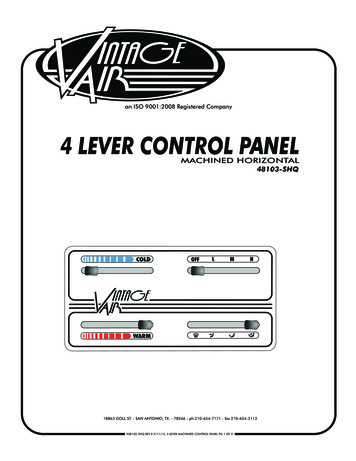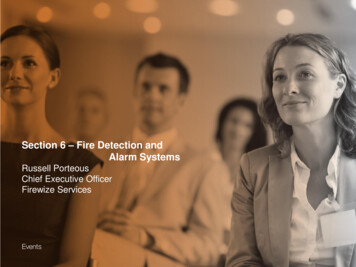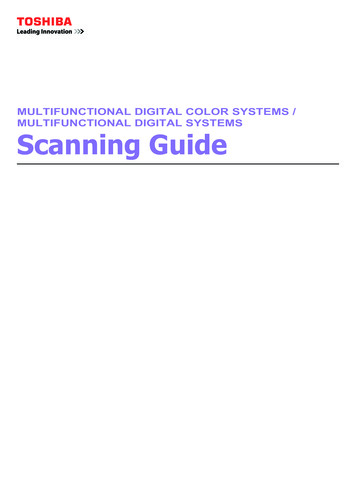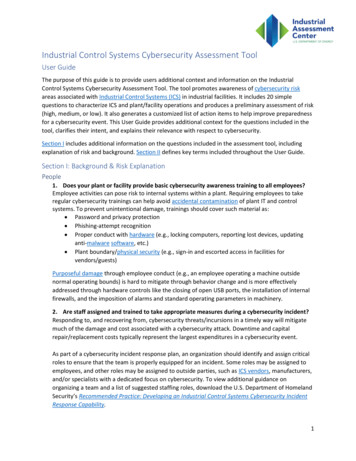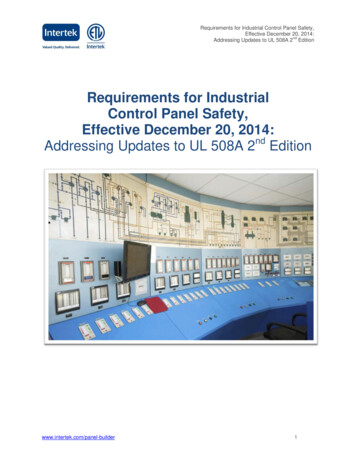
Transcription
Requirements for Industrial Control Panel Safety,Effective December 20, 2014:ndAddressing Updates to UL 508A 2 EditionRequirements for IndustrialControl Panel Safety,Effective December 20, 2014:Addressing Updates to UL 508A 2nd Editionwww.intertek.com/panel-builder1
Requirements for Industrial Control Panel Safety,Effective December 20, 2014:ndAddressing Updates to UL 508A 2 EditionContentsIntroduction . 3Timing . 4Overview of Changes . 4Fountain and Irrigation System Control Panels .4Transformer and Power Supply Secondary Grounding .5Identification of Grounding and Grounded Circuit Conductors and Terminals .6Internal Wiring .7Disconnect Switches.7Other Circuit Components .8Service Equipment Use .8Short Circuit Current Ratings (SCCRs) for Industrial Control Panels.9Standard Changes: Clause by Clause Resource Guide. 10Becoming and Staying Compliant . 21Contact Us . 21www.intertek.com/panel-builder2
Requirements for Industrial Control Panel Safety,Effective December 20, 2014:ndAddressing Updates to UL 508A 2 EditionIntroductionThe standard for the safety of Industrial Control Panels, UL 508A, released its 2nd Edition at theend of 2013. Now, an effective date for many additions, revisions, and deletions to the standardis quickly approaching. That effective date—December 20, 2014—represents an enforceabledate for requirements for the entire UL 508A 2nd Edition, including many changes that previouslywere unenforced. In order to stay compliant and keep production moving, Industrial ControlPanel manufacturers need to be prepared.UL 508A covers Industrial Control Panels and Industrial Panel Enclosures operating at 600 voltsor less and intended for applications of general industrial use and specific use. These specificuse applications can include elevator control, crane or hoist control, service equipment use,marine use, air conditioning and refrigeration equipment, as well as for control of industrialmachinery and more. The UL 508A standard directs manufacturers on various issues regardingIndustrial Control Panels and Industrial Panel Enclosures, including appropriate componentselection, wiring methods, and calculation of Short Circuit Current Ratings (SSCR).The standard’s update addresses safety for Industrial Control Panels and Industrial PanelEnclosures, helping to ensure a certified safe environment where this type of equipment is inuse. Additionally, changes in the standard can potentially help in providing better cost and timeefficiencies for manufacturers in the production of Industrial Control Panels and Industrial PanelEnclosures.Manufacturers of Industrial Control Panels and Industrial Panel Enclosures need to have a copyof the UL 508A 2nd Edition standard for reference and compliance. Additionally, this white paperincludes references to tables, figures, and clauses not incorporated into this document, and inthose cases, manufacturers should refer to their own copy of the standard in order to continueto be correct in their observance of its requirements.The changes to UL 508A 2nd Edition are numerous, so to help ensure compliance with therevised standard, this white paper offers an overview of some of the major changes for thissecond edition, as well as includes timeline information. Please note, Industrial Control Panelscan vary greatly and this paper is unable to cover all the intricacies of UL 508A, so it is highlyrecommended that manufacturers work with a Nationally Recognized Testing Laboratory(NRTL) partner in order to ensure optimum compliance.www.intertek.com/panel-builder3
Requirements for Industrial Control Panel Safety,Effective December 20, 2014:ndAddressing Updates to UL 508A 2 EditionTimingThe 2nd Edition update of the UL 508A standard was issued on December 20, 2013, with arevision released on January 13, 2014. As noted above, the effective date for compliance withthis UL 508A 2nd Edition is December 20, 2014—a date that is imminent—and a variety ofpreviously unenforced requirements will now be effective in order for Industrial Control Panels tobe compliant.Many manufacturers are already ensuring, completing, instituting, or working on adjustments inorder to comply with the new edition of this standard, and third-party certification companies areassisting manufacturers on a case-by-case basis to ensure the compliance of all equipmentgoverned under UL 508A. However, time is certainly of the essence here, as there is only ashort window to ensure a company’s production is in proper compliance in order to continuemanufacturing.Overview of ChangesWhile this paper does provide information on several of the changes manufacturers may needto address in order to become or stay compliant with UL 508A, it does not in any way constitutea comprehensive overview of all the additions, revisions, and deletions to the standard thatbecome effective December 20, 2014. As one example, multiple clarifications on what the scopeof UL 508A does not cover are not included in this paper. Other changes not addressed hereinclude revisions to clauses regarding barriers and ventilation, air conditioner control panels,field wiring, branch circuit protection, overload protection of motor loads, switching devices, andindividual load ratings.For complete information on the changes to UL 508A, as well as staying efficient and compliantwith all Industrial Control Panels and Industrial Panel Enclosures and their components, contacta third-party testing and certification company (see page 21).Fountain and Irrigation System Control PanelsOne of the largest changes for this 2nd Edition of UL 508A is the addition of specific userequirements for Control Panels for Fountain Control and Industrial Control Panels forIrrigation Equipment. Previously, these were regulated under the general industrial usestandards. Now, Fountain Control Panels—including general information, construction,grounding, grounding–fault protection, equipotential bonding, cord strain relief, ratings andmarkings—are detailed in Clauses 93–96 of UL 508A, and Irrigation Equipment Control Panelwww.intertek.com/panel-builder4
Requirements for Industrial Control Panel Safety,Effective December 20, 2014:ndAddressing Updates to UL 508A 2 Editionstandards are now explained in Clauses 97–99. These Irrigation Equipment-specific clausesaddress topics including general information, construction, size of motor controller,disconnecting means, branch circuit protection, internal conductors, and markings.Transformer and Power Supply Secondary GroundingClause 16, which focuses on Transformer and Power Supply Secondary Grounding underAll Panels, discusses how a bonding jumper is required for electrical systems that must begrounded, whether at the service or a separately derived source. The standard previouslyreferred to both types of bonding jumper as the “main bonding jumper,” but to clarify anddifferentiate between bonding jumpers at the service entrance and those provided for aseparately derived system, Clause 16.2 now refers to the bonding jumper for a separatelyderived system as a “system bonding jumper,” and Table 75.1 (see standard) utilizes the sameterminology. Additionally, the new Exception No. 2 under Clause 16.2 and revision to Clause54.10, which focuses on field wiring terminal markings, add an option for a single groundingelectrode conductor terminal to be supplied to terminate a single grounding electrode conductorthat serves to simplify the installation and eliminate the need for multiple grounding electrodeconductor terminals where multiple derived systems are provided. Also, a new Exception underClause 54.10 states, “When a single grounding electrode conductor terminal is supplied formultiple separately derived systems in accordance with Exception No. 2 to 16.2, the marking in54.10 shall specify that a 3/0 AWG grounding electrode conductor is required to connect thegrounded conductors of multiple separately derived systems to a grounding electrode.”In Clause 16.4 it is now required that ungrounded secondary circuits greater than 100 volts beprovided with a means to identify when a ground fault has occurred in any of the circuitconductors. Not all secondary voltages are required to be grounded by Clause 16.1. For thosesystems that were ungrounded, there was no means for detecting a ground fault in thesecondary circuit, and a second fault could either trip the overcurrent protection or create aparallel circuit path via conducting parts. Additionally, in Clause 66.3.2 (which covers IndustryMachinery panels), a clarification and an Exception were added. Clause 66.3.2 now states thesecondary winding of not only a control transformer but also the secondary of a power supply isnot required to be grounded when the secondary supplies only devices included as part of thecontrolled machine, not other machines or circuits, and is provided with a monitoring device.The new Exception for Clause 66.3.2 notes, “A control circuit, as described in 66.3.2, suppliedfrom a secondary of a Class 2 transformer or Class 2 power supply is not required to besupplied with a monitoring device or a ground fault protective device.”For Clause 16.5 an industrial control panel that contains a transformer or power supply with a 3phase, 4-wire delta secondary, as described in 16.1(d) (see standard), and provided with fieldwww.intertek.com/panel-builder5
Requirements for Industrial Control Panel Safety,Effective December 20, 2014:ndAddressing Updates to UL 508A 2 Editionwiring terminals for loads to be connected between a phase and the neutral, shall comply withClause 29.3.13. Clause 29.3.13 states an industrial control panel constructed specifically forconnection to a 3-phase, 4-wire delta supply, such as shown in Figure 75.7 and 75.8 (seestandard), and provided with internal components connected between a phase and neutral, oran industrial control panel that contains a transformer or power supply with a 3-phase, 4-wiredelta secondary, as described in 16.1(d), and provided with field wiring terminals for loads to beconnected between a phase and the neutral, shall have the internal conductor or bus barconnected to the phase having the higher voltage to ground to be identified by the color orangeat each termination point.Identification of Grounding and Grounded Circuit Conductors and TerminalsSimilar to the identification marker requirement now outlined in Clause 29.3.13, Clause 17,Identification of Grounding and Grounded Circuit Conductors and Terminals under AllPanels, now includes several color identification requirements.Clause 17.4, new Exception No. 4 states, “Insulated conductors of a multi-conductor cablecolored other than as in 17.4 (white or gray or by three continuous white strips on other thangreen) shall be identified at each termination point by a white marking, such as tape wrappedaround the conductor.”The new Clause 17.5 also requires a unique identification to grounded circuit conductors thatare supplied from different grounded systems. It will be effective that where more than onegrounded circuit conductor is identified within an industrial control panel, each grounded circuitconductor shall:a) have the insulation colored white or gray or by three continuous white strips on otherthan green, or an outer covering identified by the color white or gray with a colored stripeother than green running along the length of the insulation; andb) identified by means in (a) that is different than the grounded circuit conductors ofanother system and no other conductors in the industrial control panel shall be soidentified.Clause 17.6 also now clarifies that a grounded circuit conductor provided as part of a flexiblecord must have a means to identify the grounded circuit conductor. The new Clause 17.6 states,“A grounded circuit conductor of a flexible cord shall be identified by one of the following means:a) A white or gray outer finish;b) A braid with an outer finish colored white or gray; orc) A white or gray tracer woven into the braid of contrasting color and no otherconductor in the cord having a tracer.”www.intertek.com/panel-builder6
Requirements for Industrial Control Panel Safety,Effective December 20, 2014:ndAddressing Updates to UL 508A 2 EditionInternal WiringClause 29, Internal Wiring under Power Circuits, deals with some new requirements too. Thenew Clause 29.3.12, addressing wiring methods, notes that, “Unless otherwise marked, theintended phase arrangement on 3-phase horizontal and vertical buses shall be A, B, C fromfront to back, top to bottom, or left to right, as viewed from the front of the industrial controlpanel; and on 3-phase, 4-wire, delta-connected systems, the B phase shall be that phasehaving the higher voltage to ground. Where the intended bus bar phase arrangement differsfrom the above convention, each bus bar shall be marked to identify the intended phase at eachtermination point.”A change to Clause 29.3.13 is described above in the changes to Clause 16.Also, for Clause 29.4.4, regarding routing of internal wiring, the standard previously requiredwiring subject to movement, flexing, handling, or manipulation during its intended use or duringmaintenance be provided with insulation at least 1/32 inch (0.8 mm) thick where it is flexed. Thisrequirement has been removed, which will allow the use of many additional types of insulatedconductors and could reduce the bulk of bundled conductors to doors. The additional protectionof the conductors, which has always been required, will now be more important if using thinnerinsulated conductors.Disconnect SwitchesAddressed in Clause 30, Disconnect Switches under Power Circuits, bypass circuits arecommonly installed in industrial control panels containing variable speed drives. In such cases,a motor disconnect is often used to disconnect the variable speed drive while the motor isoperated in bypass mode. A single set of branch circuit fuses or circuit breaker is used as thebranch circuit protection for the motor circuit in either mode, with the drive controlling the motoror in bypass.As the branch circuit protection is on the line side of the manual motor controller, the installationmeets the current Clause 30.3.3 of UL 508A. However, manufacturers have questioned whetherthe installation still complies with 30.3.3 when the drive circuit or the variable speed drive itselfcontains semiconductor fuses that are fast acting under short circuit conditions and where thesefuses are on the load side of the manual motor controller. UL added the new 30.3.3.1 (1stedition), now Clause 30.3.4 (2nd edition), that specifically permits the installation of a manualmotor controller on the line side of semiconductor fuses protecting variable speed drive circuitsonly when additional branch circuit protection devices are installed on the line side of themanual motor controller disconnect switch in accordance with 30.3.3. Clause 30.3.4 states, “‘Awww.intertek.com/panel-builder7
Requirements for Industrial Control Panel Safety,Effective December 20, 2014:ndAddressing Updates to UL 508A 2 Editionmanual motor controller marked, “Suitable as Motor Disconnect” is able to be installed on theline side of semiconductor fuses protecting power conversion equipment, as in 31.1.3, whenseparate branch circuit protective devices are also installed on the line side of the manual motorcontroller as in 30.3.3. In this case, the branch circuit protective devices on the line side of themanual motor controller shall comply with 31.3, as they serve as the branch circuit protection,and the semiconductor fuses are considered as supplementary protection.’”Other Circuit ComponentsClause 36 looks at Other Circuit Components under Power Circuits, and under Clause36.3.5, regarding surge control devices, the current requirements assume a surge arrestor isinstalled on an electrical system that has been solidly grounded. Surge arrestors for othersystems are specially designed for the purpose and are marked to indicate the system orsystems on which they are intended to be installed. The addition of Clause 36.3.5 clarifies thatsurge arrestors supplied as part of an industrial control panel shall have been evaluated for theelectrical system arrangement provided. The clause states, “‘A surge arrestor or a transientvoltage surge suppressor marked with a slash voltage rating shall only be used in a circuitwhere the source is solidly grounded as noted in 16.3 [see standard] when voltage is fromtransformer or power supply provided within the industrial control panel, or by marking the slashvoltage rating on the industrial control panel nameplate in accordance with 49.6(a) [seestandard], as appropriate. A surge arrestor or transient voltage surge suppressor marked foruse on a delta system, such as “600V delta”, can be used on either a wye or a delta system.’”Service Equipment UseClause 75 deals with Construction under Service Equipment Use, and Clause 75.4 focuseson disconnecting means. Clause 75.4.3 permits a maximum of six disconnecting means withoutexception. However, now Clause 75.4.4 allows separate disconnecting means for transientvoltage surge suppression, ground fault equipment, and the control circuit of power-operateddisconnecting means to not be counted toward the total number of disconnecting meanssupplied with an industrial control panel. Clause 75.4.4 states, “A disconnecting means fortransient surge protection, ground fault equipment, and the control circuit for power operateddisconnecting means shall not be counted towards the number of disconnecting means allowedby 75.4.3.”Also, Clause 75.6.1, focusing on ground-fault protection, saw changes. The original and currentclause states, “A device provided for ground fault protection for equipment as required in 75.6.2shall comply with the requirements in the Standard for Ground-Fault Sensing and RelayingEquipment, UL 1053.” New added text now states, “Circuit breakers that have been investigatedto the Standard for Molded-Case Circuit Breakers, Molded-Case Switches, and Circuit-Breakerwww.intertek.com/panel-builder8
Requirements for Industrial Control Panel Safety,Effective December 20, 2014:ndAddressing Updates to UL 508A 2 EditionEnclosures, UL 489 and include ground-fault protection for equipment comply with thisrequirement.”Short Circuit Current Ratings (SCCRs) for Industrial Control PanelsRegarding ratings, and specifically Short Circuit Current Ratings (SCCRs) of individual powercircuit components, Clause SB4.2.1 requires all power circuit components to be assigned ashort circuit current rating to be used in the calculation of the panel short circuit current rating. Italso provides a list of components that do not need to be assigned a SCCR. Now, ExceptionNo. 3 has been added, which states, “Enclosure air conditioners or multimotor and combinationload equipment that is cord-and-attachment-plug connected or supplied from a branch circuitprotected at 60 A or less is not required to have a short circuit current rating.”Also, Clause SB4.2.3, which requires devices with high-fault SCCRs to only be used with thebranch circuit protection specified by the component documentation, was addressed. A newException No. 4 was added, which allows the use of any current-limiting overcurrent deviceswhen the specified overcurrent device is a non-current limiting overcurrent device. The samehigh-fault SCCR can be assigned to the component where the interrupting rating of the currentlimiting overcurrent device is equal to or greater than the specified overcurrent device.For feeder components that limit the short circuit current available, Clauses SB4.3.2 andSB4.3.3 saw changes, but these were editorial in nature and clarified that branch circuitprotective devices could include combination motor controllers. However, Clause SB4.3.1 sawvery significant changes for branch circuits supplied by a power transformer. The 1st Editionrequirements were simplistic and only allowed the transformer branch circuit to be assigned thefault current rating of the feeder BCPDs (Branch Circuit Protective Devices) when thetransformer was not more than either 10kVA or 5kVA when all components in the secondarycircuit had SCCRs (short circuit current ratings) of at least 5kA or 2kA, respectively. Atransformer over 10kVA was not considered to be current limiting. The new requirements (in the2nd Edition) now allow a formula to be used to calculate the short circuit current of the secondarywinding when the transformer has a marked and known impedance. Also, there are now tablesthat can be used to determine the worst case available short circuit secondary current fortransformers from 1kVA to 75kVA when the transformer has no marked impedance or with amarked or known impedance of not less than 2.1% (see standard). Also now the interruptionrating of the feeder BCPDs can be assigned to the transformer branch circuit where the shortcircuit and interrupting rating of all components in the secondary circuit are not less than thecalculated secondary short circuit current or the corresponding available short-circuit currentshown in Column 2 of the appropriate Table (see standard). This will allow some circuits withsecondary components with lower SCCRs to be assigned higher SCCRs, and will allow in somewww.intertek.com/panel-builder9
Requirements for Industrial Control Panel Safety,Effective December 20, 2014:ndAddressing Updates to UL 508A 2 Editioncases an increased short circuit current rating for circuits with transformers rated greater than10kVA.Additional information on additions, deletions, and revisions to UL 508A 2nd Edition can be foundin this paper’s next section, Standard Changes: Clause by Clause Resource Guide.Standard Changes: Clause by Clause Resource GuideThe following offers additional clause-by-clause notes on changes in the UL 508A Standard 2ndEdition that may affect various manufacturers and industry stakeholders.ClauseChange1.6.5Equipment intended to control the operation of pumps dispensing gasoline orother flammable liquids is covered by the Standard for Control Equipment forUse with Flammable Liquid Dispensing Devices, UL 1238.The contents of this clause has been deleted (it would have been between newclauses 1.13 and 1.14). The current scope of UL 1238 does not permitassembly of equipment other than that used specifically for dispensingequipment. It is possible to have a panel that includes a subset of componentsfor remote control of dispensing equipment in non-hazardous locations.2.17DUTY, INTERMITTENT – Operation for alternate intervals of (1) load and noload; or (2) load and rest; or (3) load, no load, and rest.This is a new definition for the 2nd Edition.2.23The definition of FUSE, BRANCH CIRCUIT TYPE added Class CF fuses.7.1aThis clause no longer references the ANSI/NFPA 70-1999 National ElectricCode. The 1999 date has been removed.16.2Revisions currently effective. Changed “main” to “system” and added Exception2.A bonding jumper is required for electrical systems that must be grounded,whether at the service or a separately derived source. Currently UL 508A refersto both types of bonding jumper as the “main bonding jumper.” To clarify andwww.intertek.com/panel-builder10
Requirements for Industrial Control Panel Safety,Effective December 20, 2014:ndAddressing Updates to UL 508A 2 Editiondifferentiate between bonding jumpers at the service entrance and thoseprovided for a separately derived system, Clause 16.2 now refers to thebonding jumper for a separately derived system as a “system bonding jumper”and Table 75.1 (see standard) utilizes the same terminology. References to thebonding jumper required at a service entrance will continue to be referred to asthe “main bonding jumper.” The requirements for determining the size of a mainbonding jumper and a system bonding jumper remain the same.16.4New and currently effective with standard:This new clause requires that ungrounded secondary circuits be provided with ameans to identify when a ground fault has occurred in any of the circuitconductors.Currently not all secondary voltages are required to be grounded in accordancewith Clause 16.1 of UL 508A. For those systems that are ungrounded, there hasbeen no means for detecting a ground fault in the secondary circuit and asecond fault could either trip overcurrent protection or create a parallel circuitpath via conducting parts. This proposal is consistent with Section 250.21(B) ofthe 2014 National Electrical Code (NEC). Note that Clause 250.21(C) of theNEC now requires these ungrounded systems to be marked “Caution:Ungrounded System Operating — Volts Between Conductors” at thesource or first disconnecting means of the system. Note that this marking is notcurrently required in UL 508A, but should be applied to comply with the NEC.16.5Previous revision currently effective with standard:An industrial control panel that contains a transformer or power supply with a 3phase, 4-wire delta secondary, as described in 16.1(d), and provided with fieldwiring terminals for loads to be connected between a phase and the neutral,shall comply with 29.3.13.17.4Previous addition of Exception No. 4 currently effective with standard:Exception No. 4: Insulated conductors of a multi-conductor cable colored otherthan as in clause 17.4 shall be identified at each termination point by a whitemarking, such as tape wrapped around the conductor.17.5New and currently effective with standard:Where more than one grounded circuit conductor is identified within anindustrial control panel, each grounded circuit conductor shall be:www.intertek.com/panel-builder11
Requirements for Industrial Control Panel Safety,Effective December 20, 2014:ndAddressing Updates to UL 508A 2 Editiona) Identified by:1) A means that complies with 17.4; or2) An outer covering of white or gray with a colored stripe other than greenrunning along the length of the insulation; andb) Identified by means in (a) that is different than the grounded circuitconductors of another system and no other conductors in the industrial controlpanel shall be so identified.The new clause requires a unique identification to grounded circuit conductorsthat are supplied from different grounded systems. The proposed requirement isconsistent with sections 200.6(D) and 200.6(E) of the 2005 National ElectricalCode.17.6New and currently effective with standard:A grounded circuit conductor of a flexible cord shall be identified by one of thefollowing means:a) A white or gray outer finish;b) A braid with an outer finish colored white or gray; orc) A white or gray tracer woven into the braid of contrasting color and no otherconductor in the cord having a tracer.The new clause clarifies that a grounded circuit conductor provided as part of aflexible cord must have a means to identify the grounded circuit conductor. Theproposed requirement is consistent with sections 200.6(C) and 400.22 of the2005 National Electrical Code.22.1Ventilation openings less than 12 inches from a possible source of arcingrequire an interposing barrier between the ventilation opening and the source ofarcing. The new clause has removed reference to a fuse as a possible sourceof arcing.Some constructions may be allowed to have barriers removed if they wereplaced there because of the presence of a fuse less than 12 inches from aventilation opening.26.3This clause has been expanded to include air conditioners evaluated to UL1995. Clarification on how to use the environmental ratings of an enclosure airconditioner in determining the panel rating was also added. Supplement SAalso clarified that Listed UL 1995 air conditioners may be used, but neither UL1995 nor UL 484 Recognized air conditioners may be used without furtherwww.intertek.com/panel-builder12
Requirements for Industrial Control Panel Safety,Effective December 20, 2014:ndAddressing Updates to UL 508A 2 Editionevaluation.26.3.1 – For air conditioners, added “or the Standard for Heating and CoolingEquipment, UL 1995.”26.3.2 – For an air conditioner as described in 26.3.1 that is marked with an“interface” environmental rating, such as Type 1 enclosure with Type 12interface, the “interface” type rating marked on the component is used as thebasis for compliance with Table 19.1 (see standard).28.3.7Addition of requirements for controllers for multi-speed and part-winding motors.The current requirements in UL 508A do not specifically mention part-windingmotors. This interpretation clarifies the output load rating, sizing of field wiringterminals, and other related construction requirements that apply to part-windingmotor circuits. These requirements are consistent with Section 430.4 of theNational Electric Code.New 28.3.7 — Field wiring terminals intended to carry the current of a partwinding motor, where half of the motor winding is energized during starting andthe remaining half of the motor winding is subsequently energized
UL 508A covers Industrial Control Panels and Industrial Panel Enclosures operating at 600 volts or less and intended for applications of general industrial use and specific use. These specific use applications can include elevator control, crane or hoist control, service equipment use,







